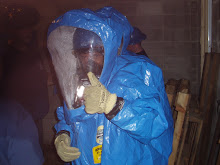I was working this weekend teaching hazmat. Talking with another instructor, who is a career firefighter, about workplace injuries. Some occupations are inherently risky. Some require employees to take "calculated" risks inorder to save anothers life. During the risk evaluation, we try to evaluate all hazards and come up with a plan to acheive our goal. Sometimes this is formal, sometimes informal. When someone gets injuried during this task, then people sit down to make sure that it doesn't happen a gain. Which is great, but what about the tasks that almost lead to an injury or a Near Miss. If we spend some time looking at the almost injuries, we can reduce our actual injuries. For firefighers, a national reporting system exists, but not many know about it or use it. Here is a link. http://www.firefighternearmiss.com/
Every sector of business can benifit from a near miss reporting program, wether internal or external.
Monday, March 8, 2010
Wednesday, March 3, 2010
Why pay for Safety?
A little story about a friend.
My friend was cutting wood with a new chain saw. Everything was progressing well, lots of progress, sharp chain and plenty of wood to cut. My friend had his safety gear on, safety glasses, ear plugs and steel toed shoes. When he was finished cutting the log, as he had done hundreds of times before, he moved the saw, which unfortunately contacted his upper thigh. Luckily, between the insulated coveralls, jeans and the key fob for his truck, there was no injury. A near miss. This is a great lesson learned, but not the only lesson to learn.
After talking with my friend, this is not the first time that this had happened. He has other jeans that bear the jagged rip of the chain saw. Why did he not learn the first time? What was he thinking?
Well, turns out after the first time, he looked into kevlar chaps to protect his legs. But, they were $100. A little more than he wanted to pay. So, you guessed it, no chaps!!
Why is it that when it comes to accident or injury prevention, we are reluctant to pay money up front? I know for sure that if he had actually cut his leg, he would have paid a lot more than $100, and wished he had bought the chaps.
It seems that for some people, they are willing to gamble that "it won't happen to me". In case it does, I have workers comp or insurance to cover it. But what about the non-tangible costs like pain, inconvienence, guilt, lost productivity, mobility etc.
In my book, prevention is a better route to take. It is an easy concept to understand, yet our practice is not what we preach.
My friend was cutting wood with a new chain saw. Everything was progressing well, lots of progress, sharp chain and plenty of wood to cut. My friend had his safety gear on, safety glasses, ear plugs and steel toed shoes. When he was finished cutting the log, as he had done hundreds of times before, he moved the saw, which unfortunately contacted his upper thigh. Luckily, between the insulated coveralls, jeans and the key fob for his truck, there was no injury. A near miss. This is a great lesson learned, but not the only lesson to learn.
After talking with my friend, this is not the first time that this had happened. He has other jeans that bear the jagged rip of the chain saw. Why did he not learn the first time? What was he thinking?
Well, turns out after the first time, he looked into kevlar chaps to protect his legs. But, they were $100. A little more than he wanted to pay. So, you guessed it, no chaps!!
Why is it that when it comes to accident or injury prevention, we are reluctant to pay money up front? I know for sure that if he had actually cut his leg, he would have paid a lot more than $100, and wished he had bought the chaps.
It seems that for some people, they are willing to gamble that "it won't happen to me". In case it does, I have workers comp or insurance to cover it. But what about the non-tangible costs like pain, inconvienence, guilt, lost productivity, mobility etc.
In my book, prevention is a better route to take. It is an easy concept to understand, yet our practice is not what we preach.
Saturday, February 20, 2010
Reading Smoke
I went to a training class this morning called Fire and Smoke. The instructor was with the Illinois Fire Service Institute. He was great. It is amazing how some times the smoke will tell you whats going on, but other times it does not. You may have heard of the terms backdraft and flashover, but what about smoke explosion? A smoke explosion is when there are super heated gases at their ignition temperature, just waiting for an ignition source. These explosions are strong enough to blow firefighters off their feet. To see an example, check out this video clip. http://www.youtube.com/watch?v=aTQWNCeCBvQ
There was really no advance warning for this except for a couple of seconds before the explosion. It is very important to take time to assess the situation.
There was really no advance warning for this except for a couple of seconds before the explosion. It is very important to take time to assess the situation.
Subscribe to:
Posts (Atom)


